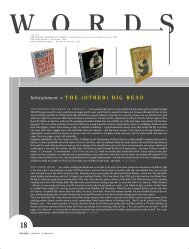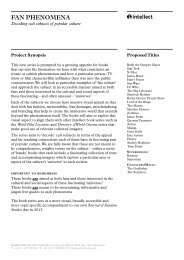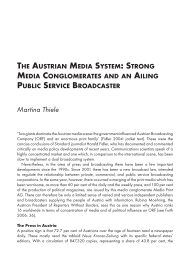Anthem - Intellect
Anthem - Intellect
Anthem - Intellect
You also want an ePaper? Increase the reach of your titles
YUMPU automatically turns print PDFs into web optimized ePapers that Google loves.
Signifying Europe<br />
The tune constitutes the climax in the final movement of a late Beethoven work that<br />
is generally understood as a high peak in his oeuvre. He was himself the last of the<br />
big three Vienna classics providing a transition from classical early modernity to the<br />
Romantics and later the self-critical fragmentation of the Enlightenment impulses.<br />
His mature period is often associated with seriousness and wisdom. The main tune of<br />
the final movement thus draws a great work to a conclusion. Romain Rolland regarded<br />
Beethoven’s ‘immortal Ode to Joy’ as ‘the plan of his whole life’: ‘All his life he wished to<br />
celebrate Joy; and to make it the climax of one of his great works.’ 363 In many respects,<br />
the <strong>Anthem</strong> bears the mark of age, maturity, finality, rich experience and wisdom.<br />
However, this stands in opposition to some aspects of the musical composition—as<br />
well as of the lyrics—that have an almost revolutionary and almost naïvely youthful<br />
urgency.<br />
The music itself is in the centre of the classical European art music tradition,<br />
using the twelve-tone equal temperament foundation of major/minor tonality and<br />
functional harmonics that underpinned new modes of modern musical narrative<br />
through structural progression and tension development, including verse/chorus<br />
transitions as well as the sonata form. These creative tools evolved from late sixteenth<br />
to early nineteenth century Europe and enabled a series of new modes of musical<br />
expression corresponding to the lifeworlds and outlooks of an emerging modern<br />
society, with the bourgeois public sphere as an important hub of civil society.<br />
Big changes took place in the period around the French Revolution, as the postaristocratic<br />
ruling classes took over the initiative and strived to construct a more<br />
suitable sound organisation that emphasised individualised emotional development,<br />
but also lifted up popular expressions in sublimated and refined forms into a more<br />
elevated sphere of fine arts.<br />
Nicholas Cook has succinctly pointed out that Beethoven’s music is full of<br />
contradictions and ambivalences: between unity and fragmentation, energy and<br />
despair, Classicism and Romanticism, seriousness and ironic jokes, sorrow and<br />
happiness, solemn abstraction and physical force, high art and ‘low’ popular<br />
earthiness, and universality and subjectivity. 364 This music in many respects expressed<br />
and tried to come to grips with basic contradictions in emergent bourgeois society<br />
and culture. 365 Susan McClary describes this music as juxtaposing ‘desire and<br />
unspeakable violence’: ‘The Ninth Symphony is probably our most compelling<br />
articulation in music of the contradictory impulses that have organized patriarchal<br />
culture since the Enlightenment.’ 366 János Márothy has argued that the early<br />
nineteenth century bourgeoisie developed a kind of ‘Dionysian complex’, resulting<br />
from a basic contradiction of bourgeois society and art: an ‘insoluble duality of the<br />
citoyen-bourgeois’. 367 Modern life had become abstract and private, creating a nostalgic<br />
longing for public collective experiences. The loss of public experiences of Dionysian<br />
mass collectivity of antiquity was recovered in romantic events, sparked off by the<br />
162












